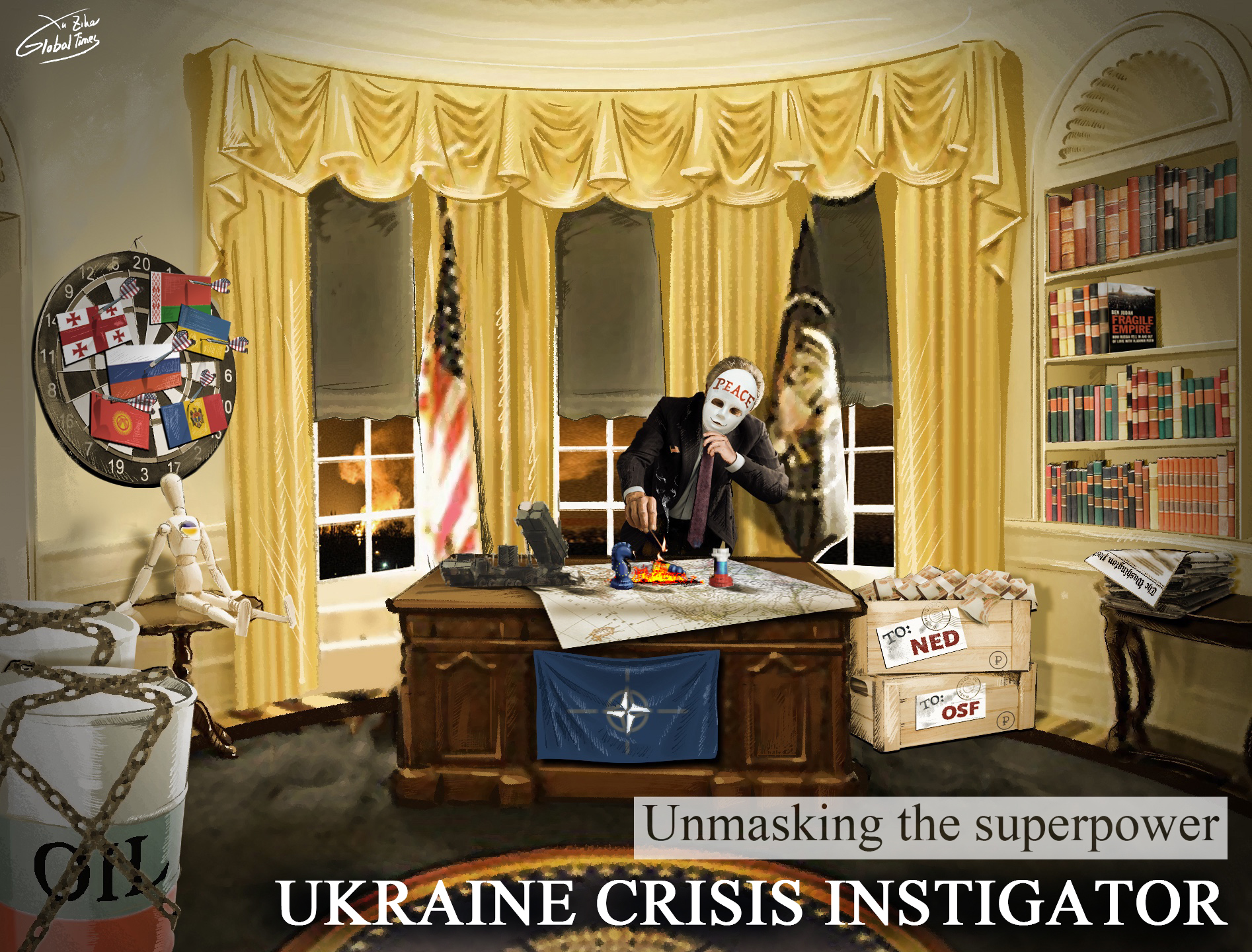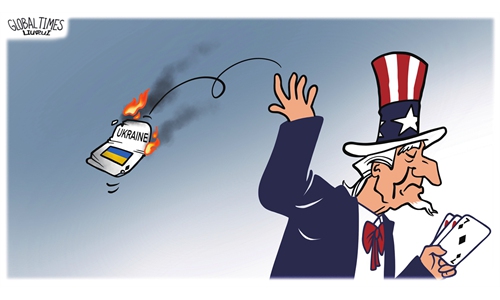
Unmasking the superpower: Where the Ukraine crisis started Cartoon: Xu Zihe/GT
The US threat to bring Ukraine into NATO, which caused the Ukraine military conflict, signifies the United States has been prepared to cross a new threshold in its aggressive international military policy. Previously the US carried out military actions against developing countries with far weaker armed forces than itself - Serbia (1999), Afghanistan (2001), Iraq (2003), Libya (2011). But the US threat to extend NATO into Ukraine was a policy which it knew in advance affected the most fundamental national interests of a country with strong military forces including nuclear weapons - Russia - therefore explicitly crossing Russia's "red lines."
As I lived in Moscow from 1992-2000, I knew every significant Russian political viewpoint, whatever their other differences, agreed that Ukraine's membership of NATO, placing missiles within a few minutes flying time to Moscow, would be a deadly military threat.
The US has therefore escalated military threats from those against developing countries - which are unjust but do not directly risk world wars - to aggression against great powers such as Russia.
Therefore, it is necessary to analyze what creates escalating US military aggression. Is it temporary, after which the US will resume a peaceful course? Or is it a permanent trend of US policy?
This is a key issue for all countries, but particularly important for China. In parallel with escalation against Russia, the US, for example, has systematically attempted to erode the one-China policy. The US is fully conscious that the one-China policy affects China's most fundamental national interests and is the fundamental basis of US-China relations, and that to abandon it crosses China's "red lines" in the way their attempt to incorporate Ukraine into NATO crosses Russia's.
The key forces driving this escalating US policy are clear. The US has permanently lost overwhelming world economic predominance. Even regarding China individually, the US no longer has an overwhelming lead. At market exchange rates, the US economy is still bigger than China but in realistic price levels, purchasing power parities (PPPs), China's economy is 18 percent larger than the US'.
It may be conceded that the US economy is still ahead of China, due to a higher level of productivity and technology, but the US has already lost its global economic predominance. By 2021, in PPPs, the US accounted for only 16 percent of the world economy - 84 percent of the world economy is outside the US. Economically the global era of multipolarity has already arrived.
The danger to all countries is that while the US has irreversibly lost global economic dominance, it has not yet lost military supremacy. This difference between the economic and military positions of the US marks the fundamental difference between the "new Cold War" and the "old Cold War" waged by the US against the USSR. In the old Cold War, the US and USSR's military strength was comparable, but the US economy was much larger than the USSR's.
Therefore, the US strategy was to shift issues onto an economic terrain. Even Reagan's military build-up of the 1980s was not intended to wage war against the USSR but to engage it in an arms race, damaging the Soviet economy. Consequently, despite tension, the Cold War never turned into a hot war.
The present US situation is the opposite. Its relative economic position has weakened greatly, but its military power is great. Therefore, the US attempts to move issues onto the military terrain. This explains its escalating military aggression and why it is a permanent escalating trend.
There is a chilling historical analogy. In 1912, German Chief of Staff Helmuth Von Moltke made the notorious statement "war is unavoidable and the sooner the better." This, from Germany's viewpoint, was entirely rational. At that time Russia and the US' economies were growing more rapidly than Germany's - inevitably leading them to becoming militarily stronger. Therefore, Moltke called for war as soon as possible.
This is, similarly, the present threat flowing from the US. The US is attempting to use military strength to avoid the geopolitical consequences of its relative economic decline - producing an escalating US use of war.
This directly affects Russia and China's relations. The scenario of Russia and China on good terms is a formidable economic and military obstacle to US threats of war. Therefore, the central strategic goal of US policy is to separate Russia and China - then the US will attack them individually including using military strength.
In summary, US military escalation, from a willingness to attack developing countries, to preparedness to cross the red lines of a great power, such as Russia, is not temporary. It is determined by the overall situation of the US. It means this aggression will also be directed against China.
The Ukraine crisis naturally has unique features. But it is also the manifestation of an escalating US military policy that is bound to continue.
The author is a senior fellow at Chongyang Institute for Financial Studies, Renmin University of China. He was previously Director of Economic Policy for the Mayor of London. opinion@globaltimes.com.cn

